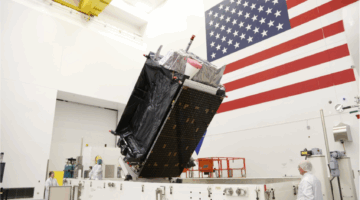
One of the stranger fallouts from Northrop Grumman’s acquisition of Orbital-ATK was Boeing’s decision to drop out of the program to replace the Minuteman III ICBM fleet. After Boeing dropped out they floated the idea of a “national team” with Northrop and Boeing to build the Ground Based Strategic Deterrent (GBSD). Northrop said, well, no. Then Northrop disclosed it faces an FTC investigation that appears to be about how it’s handling the sale of solid rocket motors for GBSD. And now we have this op-ed by two Boeing consultants — one the former commander of Air Force Global Strike Command, the other was deputy commander. They propose some wrinkles to the teaming idea. Read on! The Editor.
When it comes to replacing our ground-based intercontinental ballistic missile (ICBM), we have no time and are, in fact, “late to need.” Our current Minuteman force will become operationally unsustainable and unable to meet warfighter needs in less than a decade. On the current path, the Ground-Based Strategic Seterrent (GBSD) is at great risk of becoming yet another mega-program that fails to deliver on time. A slip of that program does not just translate to cost and schedule hits. A late ICBM replacement weakens our strategic deterrent . So, we must act – now.

Those following recent events in the ICBM replacement story are aware that one of the two contractors vying for the GBSD contract announced it will not compete for the contract. Recent reiterations of this position suggest this is not a bluff.
Some say this is not a problem, citing other single-source programs that delivered satisfactorily. Some also assert any change in the GBSD acquisition strategy at this point will jeopardize schedule. We believe this “steady as she goes” approach is fraught with risk.
The first risk is to schedule. Given the complexity of this weapon system (of systems) and the limited pool of cleared experts in the workforce, we are skeptical a single large contractor can muster the resources to deliver on-time. This mission demands the best our industry has to offer – a cleared, competent team who can build upon the lessons learned from our current ICBM program and be ready on day one.
Also, while Congress seems to have been silent thus far on the likelihood of an $85 billion sole source solution, they may not stay silent. We can only imagine the schedule perturbations an energized Congress might induce. Finally, the current course of action does nothing to insulate the program from a potentially time-consuming protest. While that may not occur in this case, recent history shows us the schedule-crushing impact large program protests can generate.
The second risk is to the quality of the weapon system. While both contractors vying for the new ICBM are extremely capable, each would privately admit that their competitors would be better suited to handle certain aspects of this complex system of systems. Proof of this is written in the last 50 years of ICBM history, as different industry partners have emerged as the go-to teams for various sub-systems and capabilities of the Minuteman and Peacekeeper systems. Asking one to duplicate what another already does extremely well is costly and time consuming. Why wouldn’t we want a solution that puts the best US industry has in the hands of our airmen?
But here we are: the nation is late to need on replacing its aging ICBM and the business as usual acquisition strategy (framed when the competitive landscape was dramatically different) is poised to deliver a potentially less-capable system, later, than operationally needed. We’re watching a car on cruise control heading for a wall.

The good news is we don’t have to drive into that wall. We can lead our way out of this and, contrary to what some suggest, we believe there is time to do so. We must use the next few months, prior to the late 2020 contract award, to implement a strategy that allows “best of breed” capabilities to be identified and pursued. We must create a framework where both of these industry leaders bring their best to the nation.
Some have called this approach a national or federated team. A federated approach could take various forms, to include a prime-principal subcontractor relationship to a government overseen relationship between two principal contractors (certainly there are other options).
Again, some suggest redirecting the GBSD strategy at this point introduces too much risk to schedule. For the reasons cited above, we believe the greater risk lies in not changing direction. Furthermore, if it’s true that a best-of-breed approach would save over two years in delivering GBSD, then any risk to schedule would be more than erased. Add to that the potential cost savings some industry experts have said a collaborative approach would generate, and 50 years of successful collaboration in ICBM development and sustainment by industry leaders, and you wonder why we haven’t already given direction to build the ICBM dream team.
We can avoid the wall if we act quickly. Let’s disengage the cruise control and build the right team. Act now.
Robin Rand was commander of Air Force Global Strike Command from 2015-2017. Michael Fortney was director of operations and vice commander of Air Force Global Strike Command from 2013-2017.

